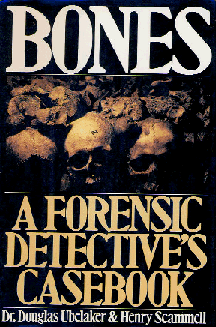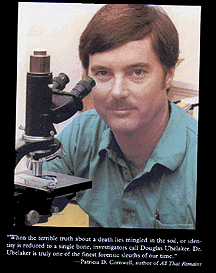Free counters provided by Andale.

(Although this book is now out of print. I would still like to call attention to it. If you are interested in reading it, check out your local library.)
Bones is definitely not for the squeamish, but it is a book that should be brought to the attention of a larger audience than this type of work would normally attract. Douglas Ubelaker at 50 seems almost too young to be one of the country's top forensic experts and a curator of physical anthropology in the Department of Anthropology, National Museum of Natural History, at the Smithsonian Institution. With his boyish smile and great sense of humor Dr. Ubelaker each spring charms an SRO class of students who eagerly sign up for his human osteology course at George Washington University. Now he has published a book about many of the cases the students learn about in his class. The subtitle "A Forensic Detective's Casebook" correctly describes the sleuth's persona one must adopt to unravel the many mysteries one bone may hold, sometimes for thousands of years. An example of the result of this type of analysis is given by Dr. Ubelaker:
The second Paleolithic man was probably a trader or some kind of
merchant. He was well into his twenties or older, solidly muscled but not
particularly heavy or tall. He was right-handed, and there was a good
possibility he excelled with the javelin. He had been in fights before;
there was an old, healed parry fracture in the bone of his right forearm,
circumstantial evidence that he had beaten his adversary in at least one
prior battle even with a broken arm. . . . He was pierced twice or more by
stone-tipped weapons, . . . one bladelet of chalcedony and another of
chert were found in the body between the lowest ribs and the spine, and it
was probable they had injured the distal ends of his right ulna . . . and
left humerus . . . in their passages. He dropped to the ground, pitching
face forward into the damp soil, and was preserved where he had fallen for
the next forty thousand years. [p. 35]
 Ubelaker writes of the great physical anthropologists who preceded him at the Smithsonian.
Larry Angel, his immediate predecessor, who said you could tell a lot about a bone by licking it.
Dr. Angel took over for T. Dale Stewart, a highly esteemed colleague, who at the age of 91 was still going
to his office in the Natural History Building from time to time. Dr. Stewart took over for Ales
Hrdlicka who was curator from 1910 until he retired in 1942. Dr. Hrdlicka, a brilliant
Czechoslovakian who never tired, was undeniably prolific in his work, and is truly a story unto
himself. Dr. Hrdlicka was the first physical anthropologist on the museum staff and the first to
start examining forensic cases for the FBI.
Ubelaker writes of the great physical anthropologists who preceded him at the Smithsonian.
Larry Angel, his immediate predecessor, who said you could tell a lot about a bone by licking it.
Dr. Angel took over for T. Dale Stewart, a highly esteemed colleague, who at the age of 91 was still going
to his office in the Natural History Building from time to time. Dr. Stewart took over for Ales
Hrdlicka who was curator from 1910 until he retired in 1942. Dr. Hrdlicka, a brilliant
Czechoslovakian who never tired, was undeniably prolific in his work, and is truly a story unto
himself. Dr. Hrdlicka was the first physical anthropologist on the museum staff and the first to
start examining forensic cases for the FBI.Dr. Ubelaker next tells of how he became interested in anthropology as a student. He started at the University of Kansas as a pre-med student, but after taking an introductory course in anthropology taught by William Bass and spending a summer doing fieldwork in the Dakotas with Bass, he was drawn to anthropology because, as he says:
. . . the real impact of the experience was in my new appreciation of
knowledge for its own sake. The site held so many secrets worth
knowing, so many stories that deserved telling, and so much information
that illuminated our own culture as well as the ones we were
studying--all brought back to life through the careful application of
science and technology in ways I'd never before imagined. [p. 45]
It is not hard to see why Dr. Ubelaker chose forensics. He writes about the exciting, high-tech
detective work of the FBI further on in the book:
. . . with infrared spectroscopy, X-ray diffractrometry, emission
spectrometry, gas chromatography, mass spectrography, and other state-of-
the-art instrumentation, backed up by some of the world's most extensive
sample files, examiners can identify just about any material on the face
of the earth. From a single chip of paint, they can name the year and make
of any automobile built in America, and most imports. . . . They can
frequently identify the manufacturer from bits of timing mechanisms and
radio controls use to make bombs, and track the source of tapes that
held bombs together, tied hostages, or bound packages of drugs. [p. 72]
Dr. Ubelaker goes on to detail how a forensic anthropologist goes about his investigations, the methods he
uses, what he can determine from certain clues, for example:
Adipocere . . . is a waxy, brownish substance resulting from chemical
changes in soft tissues which have been buried or immersed for long
periods in moisture, such as a bog or pond, a cave, or a damp grave. For
a long time it was thought to be the result of the body turning literally
to soap, and that is nearly what happens; chemically, it consists of fatty
acids formed by the hydrolysis and hydrogenation of body fats after death.
Depending on conditions, the skin of an adipocered body can become as
hard and leathery as bacon rind or an old boot, and eventually the
remains take on many of the properties of a mummy. [pp. 150-151]
He mentions other forensic experts such as Lew Sadler, a forensic sculptor who made many important contributions to the art of facial reproduction, one of which was a laser-guided system that predicts what a missing child will look like at various intervals on the road to maturity.
Dr. Ubelaker dedicates much of the book to describing how he unraveled some of the more interesting forensic cases of his career . . . and some of the saddest. In Chapter 24, "Brief Lives," he tells of two cases, one of which I will relate below. He states:
A tradition of forensic anthropologists . . . is that they keep a
certain distance from their cases . . . But there's a risk in being
too careful. . . . [T]he result of deliberately suppressing human values
in a case is that the real meaning of a life can disappear under piles
of data . . . [p. 286]
I am purposely quoting Dr. Ubelaker in detail because I feel there is a great need to tell stories like this--and to question our humanity when stories like this must be told.
One case was the body of an elderly black female. She lived alone in an otherwise abandoned building. Neighbors had reported to the police that they had not seen her in months. When the police went to investigate they found mounds of mail and were met with an overwhelming stench.
Lined up neatly against the wall in a room in the rear was a row of metal
cans containing human waste. Rat feces were all over the floor, mixed in
with a few scattered items of apparel, and months of dirt, trash, and fallen
plaster. . . . The apartment had no running water, no electricity, no heat.
The woman's body was lying on its back on the floor of the living room. . . . [p. 287]
A green-and-red floral-patterned window drape, with the hooks still in it,
was swaddled about her for warmth. Under the drapery was a loosely woven
ropelike shawl. She had on a white coat, and beneath that, a blue suit
jacket. Under the jacket was a tan sweater, and the layer below that was a
set of heavy underwear. She was still wearing one nylon stocking. The
right foot had been gnawed from the leg and dragged to a far corner of the
room by rats, and the chewed bones of her hands were scattered as far as
the entrance hallway. . . . [p. 287]
Although the cause could not be determined with certainty, the evidence
pointed to the probability that the woman had frozen to death in the
middle of winter. . . . In her final months she had probably suffered from
some mild form of senile dementia. . . . [I]t seemed likely she had also
suffered from malnutrition and neglect. . . . [p. 289]
. . . I recall being nearly overwhelmed by the horror and loneliness
of a death that was simply a mirror to the horror and loneliness of her life.
It occurred to me that the only thing that really made her death any
different was that at last, here on the medical examiner's loading platform,
she was finally getting the one thing she had lacked in life--understanding
and attention. I keep thinking, even now, what that says about our country. . . .
Here was a lost, lonely, unstable woman, freezing to death in the midst
of this great city in the richest, most powerful nation in the history of the
world. Wrapped in her print drapes, unnoticed, unreached by the resources
around her. This work we were doing on her remains was her last opportunity
to be recognized, to express her plight, to have her identity
documented and to leave some record of her life. [p. 289]
Dr. Ubelaker concludes: "If you don't remember anything else from this whole book, I hope these two stories have the same effect on you that they've had on me, and that you can't get them out of your mind."
As I said in the beginning, this book is not for the squeamish, but if you want a bitter taste of reality it is a must read.